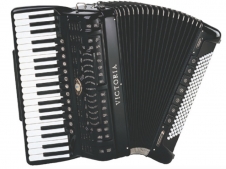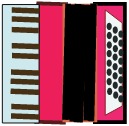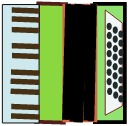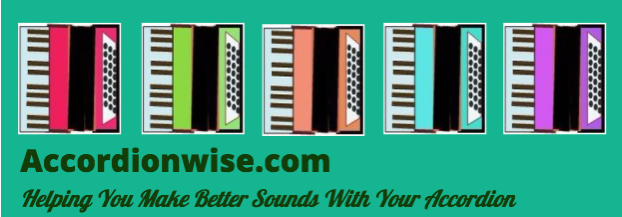I HOPE YOU ENJOY THIS WEBSITE
My name is Alex Govier, a professional musician on accordion, piano and organ for over 50 years.

On this website I am sharing stuff to
- Improve your technique
- Help you get to know your instrument better
- Play more easily and more confidently
- Try new accordion bass methods
- Integrate bass and treble sounds in different ways
- Learn how to make better music
- Gain popularity with general music listeners and not just fellow accordionists.
And yes, ALL CONTENT ON THIS WEBSITE IS FREE.
Simply because I would like more general appreciation of this wonderful instrument.
Because by playing a little more thoughtfully we can reach new audiences and get more recognition.
Find when there is new stuff on this website by joining our new Facebook Community
Here you can also
- interact with this website on Facebook
- Ask questions
- Request more detail on an accordion subject
- Suggest a new subject
- Tell us your own ideas and more.
The Accordionwise Friends link
You can find my personal playing sites on
More Chords You Can Play On Accordion - The Invisible Chords and Beautiful Possibilities!
 Your accordion has only rows for notes, counterbass (a major third up from the key note), and major, minor, seventh and diminished chords so that would seem to limit your options.
Your accordion has only rows for notes, counterbass (a major third up from the key note), and major, minor, seventh and diminished chords so that would seem to limit your options.
Find out here how to easily bypass those perceived restrictions and play, not only those apparently unavailable minor seventh chords, sixths, but augmented chords, suspended chords and exciting big 9ths, 11ths and more of differing types.
There is even an exciting easy to play version of your seventh chord that you can use any time to spice up your normal harmony. And an alternative version of the normal seventh chord which sounds subtly different if you have a six row bass accordion.
And great news for owners of accordions with only five rows of bass buttons who thought they were not able to play diminished chords in the bass. It is actually very very easy to find them on an 60 or 80 bass accordion.
![]()
Good News for Playing Complex Chords
Naturally occuring chord variations
Sometimes you play more complicated chords with no effort at all. If you have a C6 chord you may already playing the sixth if the extra note is in the right hand tune. Or the same for other chords which contain a number higher than 7 in their job description.
You can play a Cm7 chord by just adding the 7th Bb in the right hand to a C minor chord. Possibly even more effective for a better blend of notes if you play several notes of the Minor 7th in the right hand.
What is a 7th though?
The easy way to remember what the seventh is rather than counting seven notes up is to simply look back at the note below.
Seven notes up in music is the same as a second below, so you can think of it as one note back (remembering to make sure the distance is a whole tone, not a semitone)
So examples of the distance of a seventh.
C to Bb - D to C - A to G - Ab to Gb - F to Eb - F# to E - Bb to Ab
Easy isnt it? Of course you will also be likely to be putting your added seventh note up higher at the top of the chord if playing the whole chord in the right hand.
Although if you do put it somewhere else it is still correct, just a different inversion of the chord.
You can also play major or minor 6th chords.
For example play a C major chord with an A in the right hand (C-D-E-F-G-A = 1-2-3-4-5-6) and the total result is an C6 chord (or an A minor 7th if you add an A bass note).
How do you add the interval of the 6th?
Almost as easy as the 7th. This time if you know what the normal top note of the basic root position chord is, it will be one full tone higher.
Hence
D6=D F# A with B - Em6=E G B plus C# - so for F6 add D, for G6 add E, for Bb6 add G etc.
We will extend this idea later to even greater effect.
![]()
A simpler way of writing out the less usual chords
Building a new chord with bass note and bass chord.
 Sometimes arrangers may print the music like Dm/C the C after referring to the extra bass note to be played with it. So you can play it that way but what is it?
Sometimes arrangers may print the music like Dm/C the C after referring to the extra bass note to be played with it. So you can play it that way but what is it?
A quick recount will show you this is an inversion of Dm7 or even of F6. Perhaps a better way of getting Dm7 is D bass with F major chord. You could also spell out the chord in the right hand instead of playing the bass chord.
Another good one is Gm/C, the ear having made the reasonable assumption that the third of the chord is going to be a major third and the fifth as almost always a perfect fifth this will make a nice C9, readable in half the time it takes to work out just what note is the 9th.
This could be expressed completely of course with C major and G minor held together, but to my mind sounds too gruff, and not nicely voiced because every note is produced inside the same octave with the accordion stradella system. A bit like sitting on the keyboard!
There are innumerable possibilities for combining bass note and and different bass chords like this. And even more that seem like a good idea till you try them and find the finger positions impossible!
Unless you really enjoy risking your future playing capacity by tying your fingers into knots, your rule will be for the bass note to be lower down on the buttons than the chord part. And not too far apart of course.
![]()
The Suspended 4th and Augmented Fourth
The suspended fourth is a distorted regular chord usually a major or minor one)is really just a passing note waiting to go onto a standard chord, most often a major one. A fourth up is found by counting 4 up from the lower note to the higher note 1-2-3-4 = A-B-C-D for example.
Therefore an A6sus4 consists of an A chord which includes a 4th but no 3rd as yet, obviously a situation which needs to change soon going to a standard A or Am. So it has A D and E going to A C# E the major chord most often. It also, like all chords can be expressed as inversions with the notes in a different order upwards.
For maximum effect the rather dissonant sounding suspended fourth is likely to occur on a strong beat and quickly be "pulled" to the major chord on a weaker beat.
This fits in perfectly with the most basic standard accordion accompaniment system, So a bass note by itself on the first beat alongside the interval of the fourth. When a major chord arrives that would have clashed with it the fourth is already gone and the crisis is over!
What is a Passing note?
Passing Notes are included in music to add a bit of tension until the perfect harmony arrives). Often they are followed by a major or minor chord on the following beat.
Passing notes can also be faster notes flowing through the melody in between major beats that do not seem to require full harmonisation.
Without an element of dissonance music becomes very dull
For a perfect axample that shows what I mean play the opening of Bernstein's song Maria from West Side Story C F# G with C chord arriving on the G.
Augmented chord in a "Special 7th"
Everyone knows you cannot get Augmented chords in the bass chord buttons, there are only major, minor, sevenths and diminished right?
But you can usually get a chord which contains an augmented chord by playing any seventh chord in the left hand and an augmented chord, or a couple of notes of it in the right.
For example play C7 chord in the left hand and C augmented E G# C in the right, sounds great as an interestingly strident version of C7.
Substitute it for normal G7 wherever you like but it is especially effective as a "suspense chord" on a pause, and with the bass note played simultaneously.
SPECIAL TIP Specially strong as a holding chord in combination with the major third, eg bass E in counterbass, C7 and E G# C in treble
How On Earth Does THAT Work?
You would imagine that in that example you had a C7 chord which contained both a G and G# so was very nasty indeed, but that (at least on most accordions) is not the case.
Every chord on the accordion contains just three different notes, including the 7ths chords which would normally have four. So they usually leave out the interval of the 5th.
Hence there is NO G natural OR G# till you add it in the right hand to your C7.
Purists who want the fullest version of C7 sometimes even play both C and C7 together to get all the notes!
Find Diminished 7ths chords for 80 bass also minor 7ths
Remember that the diminished chords are also 7ths with the 5th interval removed. They are almost the same as standard 7ths, but with a minor 3rd, so C7dim has C Eb A.
Add an F# and you have your promised Cdim7 but add an F natural instead and you have an F7 chord!
You can of course also get an Fm7 with Fm and the Eb in the right hand. IT is also effective to add more than just the note you need in the right hand
But it gets even better for five row bass players. To get a Cdim7 chord or one which is compatible play F7 instead.
SPECIAL TIP
You obviously cannot move ACROSS to a 6th row on a 5 row bass instrument to get a diminished so simply move DOWN one instead! Very easy. For C dim use F7.
If your 80 or 60 bass fifth row is diminished move UP one in that row to find the relevant seventh chord. For F7 use C dim
These tips work even if you do not understand the technical explanation!
Different inversions of seventh chords
By the same principle we can find standard 7th chords which sound subtly different, in fact I think often more mellow sounding voicings of the same chord.
Let us take G7 as an example which is voiced as G B (d) F. Now take Ddim7 voiced on the accordion as D F (Ab) B.
This is the G7 without the G instead of without the D in the original version.
It is a very nice, more mellow to my ears, voicing of the chord.
Additionally by going from one to the other the bottom note of the chord moves from G to D.
For a more buoyant waltz pattern with moving chords substitute G note G7 Ddim7 for G note Gchord G chord.
Because of the way accordion bass notes are allocated this will not work the same in all keys.
![]()
TRY THIS OUT
A COUPLE OF EASY EXPERIMENTS BASED ON THIS INFORMATION
EXPERIMENT ONE Augmented chords
Play C7 chord and hold it. Add E and G sharp in the right hand.
You now have an augmented C chord with a normal 7th on top
Now holding chord and the lower right hand note change the G sharp to G natural. Only now do you have the normal C7 that you expected.
Some other examples in other keys
G7 chord with treble B and D sharp, change D sharp to D natural
D7 chord with treble F sharp and A sharp , change A sharp to A natural
A7 chord with treble C sharp and E sharp (F), change E sharp (F) to E natural
E7 chord with treble G sharp and B sharp (C), change B sharp (C) to B natural
F7 chord with treble A and C sharp, change C sharp to C natural
Bb7 chord with treble D and F sharp, change F sharp to F natural
Eb7 chord with treble G and B natural, change B natural to Bb
Ab7 chord with treble A and E natural, change E natural to Eb
Db7 chord with treble F and A natural, change A natural to Ab
EXPERIMENT TWO Different Standard F7 chords
Play C7 then overlapping slightly play G diminished one row up.
ALSO OF COURSE
G7 and D diminished 7
D7 and A diminished 7
A7 and E diminished 7
E7 and B dimished 7
Db7 and Ab diminished 7
Ab7 and Eb diminished 7
Eb7 and Bb diminished 7
Bb7 and F diminished 7
F7 and C diminished 7
Purpose of knowing this.
You may find the alternative version sounds sweeter on occasion, also if going straight from chord to chord the shifts in position of the individual notes will be different.
![]()
NOTE TO PROGRESSIVE SIX ROW BASS PLAYERS
If you have time in slow tempos try substituting seventh chords with the diminished chord above, you will probably find it sounds sweeter, due to wider spacing at the bottom, eg instead of G B (D) F you will have D F (Ab) B
Examples
- For Eb7 play Bbdim7
- For Bb7 play F dim7
- For F7 play C dim7
- For C7 play G dim7
- For G7 play D dim7
- For D7 play A dim7
- For A7 play E dim7
Beware that getting back to the key below will be more difficult though!
For diminished chords instead play the seventh chord one button BELOW
Examples
- For Ebdim7 play Ab7
- For Bbdim7 play Eb7
- For Fdim7 play Bb7
- For Cdim7 play F7
- For Gdim7 play C7
- For Ddim7 play G7
- For Adim7 play E7
Looks complicated till you try it. Then it feels obvious.
![]()
Play any chord with a right hand chord and bass note
 Add the chord to your right hand tune and just play with it on the bass notes, ignoring the chords buttons. You can thus play any chord within the stretch of your right hand.
Add the chord to your right hand tune and just play with it on the bass notes, ignoring the chords buttons. You can thus play any chord within the stretch of your right hand.
In some areas this used to be the standard way to be able to play the jazz chords, giving great freedom of choice.
Now some jazz accordionists add chords together (eg C and Gm make C9) but notes become unpleasantly squashed together where the pleasure is hearing them in different octaves (in my humble unfortunately non jazz accordionist view) and lose their nicely spread out relationship to one another.
I think it is the wonderful things they do with the right hand improvisations that distracts from this.
![]()
Bass note and chord with treble chord
However, by adding a bass chord to a played right hand chord the possivilites are practically limitless to produce a really interesting sound.
The chords can blend or be a discord leading to an obvious resolution. If the resolutiong is not obvious (as when a C11 for example comes down to a C7) there may be extra moves of the chord till it finds its ideal resting point.
This is a very small section to mention it here but actually has a huge effect and can produce a wonderful sound, particularly if the right hand chord is in a higher octave than the left hand chord.
If the chords have many notes in common there will be a simple resolution, otherwise there is the interesting process of finding one, possibly by several chord changes in the right hand.
The possibilities are almost endless.
DIFFERENT CHORD EXAMPLES - COMBINED BASS CHORD AND TREBLE WONDERFUL DISCORDS - RIGHT HAND AND LEFT HAND APPARENTLY NOT MATCHING.
An easy one for you for those who have difficulty with the concept of how wonderful it can sound when you play the "wrong chords together".
And we start out with ones that are as theoretically discordant as we can imagine.
Try this straight away.Hold a major or minor chord in the bass. YES HOLD IT DON'T JUST PROD IT!
In the treble play the chord one semitone below it before sliding up to play the "correct" chord.
Example: Hold G chord on bass buttons with the F# chord going to the G chord on the right hand on the next beat. Play C# F# A# sliding up to D G B and hear the extra musical expression you get
You are supposed to hold the discord long enough to really hear it by the way, not be afraid of it.
Also of course you can use other inversions in the right hand equally effectively.
TOO DIFFICULT? THEN TRY THIS
Just play the thirds from the chord in the right hand.
Then add a Held G bass button chord with F# A# going to G B in right hand.
Still sounds very special
STILL TOO DIFFICULT?
Just alter the top note but play the other notes of the chord or third the same.
G chord bass with D G A# to full chord D G B
OR EVEN JUST ONE NOTE NOT MATCHING
G A# to G B
BONUS DISCOVERY
With the small version and the root position right hand single note alteration you can play a suspended diminished 4th.
You can match it even more accurately by playing the seventh chord in the bass instead NB G7 in bass (which plays G B F with B and D# going on to B and D
![]()
Finding your chords in the right hand. What notes are in the chords?
Not all accordionists may already know what notes make up the chords that are played automatically for them by the bass chord selections of course. You can play very convincingly with just single note melody or adding separate notes in thirds under the tune so this is understandable.
 In case you are a bit hazy on the subject here is a brief check-list for the main root position chords. More work will be required to change the note position for the other inversions possible of course and it is quite fun to move the bottom note to the top one at a time to find the other inversions
In case you are a bit hazy on the subject here is a brief check-list for the main root position chords. More work will be required to change the note position for the other inversions possible of course and it is quite fun to move the bottom note to the top one at a time to find the other inversions
NB Number1 is the name of the chord and the first note counted
MAJOR CHORD 1 - 5 - 8
MAJOR 6th Chord 1 - 5 - 8 - 10
AUGMENTED 1 - 5 - 9
SEVENTH 1- 5 - 8 - 11
SHARPENED SEVENTH 1- 5 - 8 - 12
MINOR 1- 4 -8
MINOR 6th 1 - 4 - 8 -10
MINOR 7th 1 - 4 - 8 - 11
DIMINISHED 7th 1 - 4 - 7 - 10
SUSPENDED 4th 1 - 6 - 8
If you get confused when adding the seventh and finding a flat that does not belong to the key of the key note or a sharp missing, there is an explanation. The standard 7th chords actually belong to the key one button and one flat below and that is why they have that form of the seventh which is associated with them.
In fact they like to resolve to the subdominant major chord one flat down. C7 wants to go to F, Bb7 to Eb, A7 to D and so on.
PLAYING TIP
Too many notes to play?
You may not need to define the 5th by playing it. It is taken for granted that it will be a perfect fifth, so unless it is a strange one like a diminsihed or augmented that is OK.
One of the notes is in your bass remember? So bass C and treble E G Bb is fine. OR even a stripped down version without the (assumed to be!) perfect 5th in this case, C in the bass E and Bb in treble.





